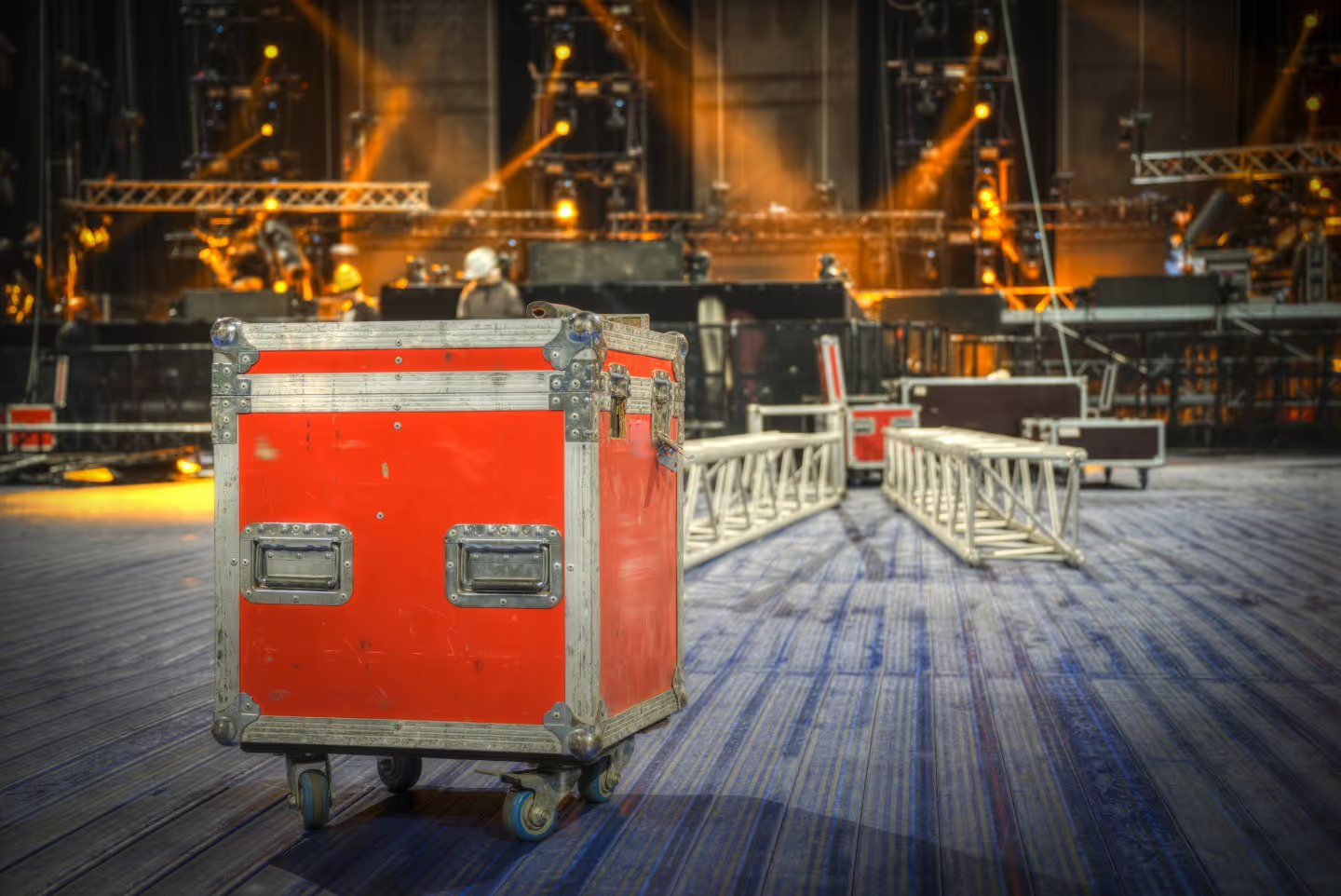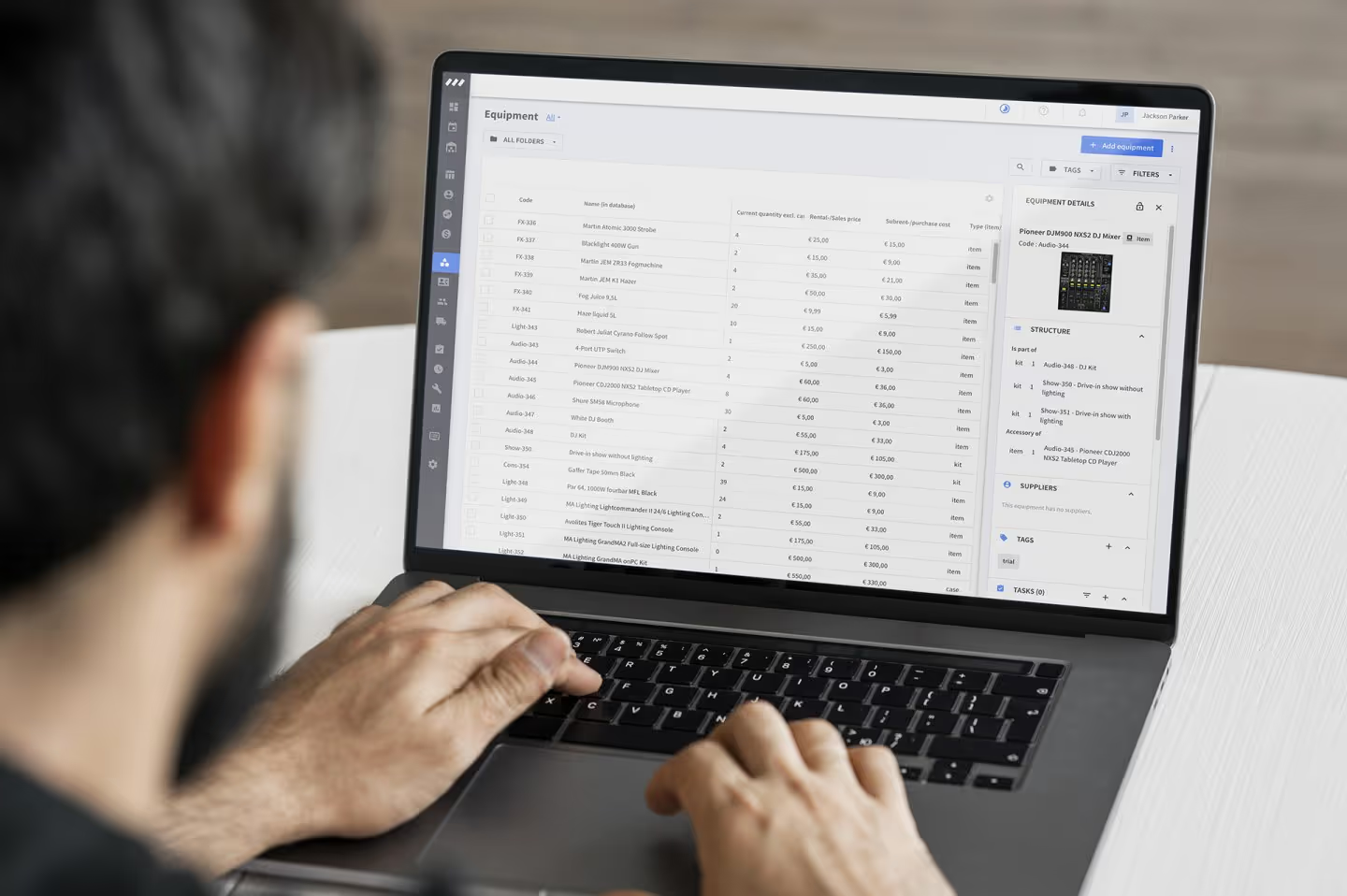Mastering Equipment Rental KPIs: A Complete Guide for Success in the Event Industry

Understanding and effectively managing equipment rental KPIs is crucial for the success of any equipment rental company or business. Key Performance Indicators, or KPIs, serve as vital tools that help measure the efficiency and effectiveness of your operations, providing valuable insights both into areas that need improvement and those that are performing well. By keeping a close eye on these metrics, businesses can make informed decisions that drive growth and profitability.
In this guide, we will delve into the essential equipment rental KPIs you need to monitor and provide practical strategies to master them for your business's success.
1. Introduction to Equipment Rental KPIs
2. Key Equipment Rental KPIs
3. How to Measure KPIs Effectively
4. Strategies for Improving KPIs
5. Future Trends in Equipment Rental KPIs
Introduction to Equipment Rental KPIs
Understanding Equipment Rental KPIs
Equipment rental KPIs are specific metrics that gauge various aspects of your event rental business's performance. These indicators help assess operational efficiency, financial health, and customer satisfaction. Tracking KPIs allows event rental businesses to pinpoint strengths and identify areas needing improvement.
For example, the utilization rate measures how often equipment is rented compared to its availability. This highlights equipment demand and helps in inventory management. Another crucial equipment rental KPI is the revenue per unit, which evaluates the income each rental item generates. Monitoring these metrics enables informed decision-making, optimizing resource allocation, and enhancing the customer experience and service.
By understanding and applying these KPIs, event rental businesses can streamline operations, boost profitability, and sustain growth in the competitive event market. Setting specific, measurable, achievable, relevant, and time-bound (SMART) goals in relation to these KPIs ensures that tracking and improvement efforts are consistently aligned with overall business objectives.
Importance of Tracking KPIs
Tracking KPIs in event rental is essential for maintaining a competitive edge and ensuring operational success. KPIs offer a clear snapshot of your business performance, highlighting areas where you excel and those needing attention. Regularly monitoring these metrics helps identify trends and patterns, allowing for proactive adjustments rather than reactive fixes.
For instance return on investment is, if the downtime rate of your equipment is high, it signals the need for better maintenance practices. Furthermore, KPIs provide a quantifiable measure for setting and achieving business goals. They also enable you to benchmark repeat business against industry standards, ensuring you stay competitive.
By tracking KPIs, you can make data-driven decisions that enhance efficiency, reduce costs, and improve customer satisfaction. Ultimately, consistent KPI tracking fosters a culture of continuous improvement, driving your business towards sustained growth and profitability in the event rental market.
Common Misconceptions
In the realm of equipment rental KPIs, several misconceptions can lead businesses astray. One common misunderstanding is believing that tracking numerous KPIs will automatically lead to success in equipment rental sector. While data is valuable, focusing on too many metrics can cause confusion and dilute strategic focus. Instead, it’s crucial to identify and monitor the KPIs most relevant to your specific goals and operations in the event industry.
Another misconception is that KPIs are static and need not change. In reality, as your event equipment rental business further evolves, so too should your KPIs. They must adapt to reflect new trends, technologies, and market conditions. Furthermore, some assume that KPIs are only for large companies with extensive resources.
However, even small event rental businesses can benefit from tracking relevant KPIs to improve efficiency and profitability. Lastly, relying solely on software to interpret KPIs can be misleading. Human analysis is essential to contextualize data and derive actionable insights, ensuring KPIs truly drive business success in the event industry.
Key Equipment Rental KPIs
Utilization Rate
The utilization rate is a critical KPI for event rental businesses, indicating how effectively the equipment fleet is being used. It measures the percentage of time equipment is rented out versus the time it is available for rent. High utilization rates suggest strong demand and effective asset management and inventory management in the event industry, while low rates may indicate excess inventory or inefficient operations.
Calculating this KPI involves dividing the total rented hours by the total available hours within a specific period. Monitoring utilization rates helps event rental businesses optimize their fleet size, ensuring they have enough equipment to meet demand without overinvesting in inventory. It also aids in identifying underperforming assets that may require reevaluation or redeployment.
By maintaining an optimal utilization rate, rental companies can maximize revenue, reduce idle time, and improve overall operational efficiency. Regularly assessing this KPI ensures that strategic decisions align with market demand and business objectives, fostering long-term success in the event rental industry.
Maintenance Costs
Maintenance costs are a pivotal KPI in the event rental industry, directly impacting profitability and operational efficiency. This metric tracks the expenses associated with keeping equipment in optimal working condition, including routine servicing, repairs, and parts replacement. High maintenance costs may signal aging equipment, inefficient maintenance practices, or poor-quality assets.
Conversely, low costs can reflect well-maintained equipment and effective preventive maintenance schedules. To calculate maintenance costs, sum all maintenance-related expenses over a specific period and analyze trends over time. Tracking these costs helps event rental businesses budget appropriately and identify cost-saving opportunities. It also aids in deciding when to repair or replace aging equipment, ensuring optimal fleet performance.
By closely monitoring maintenance costs, companies can maintain equipment reliability, enhance service quality and customer satisfaction, and avoid unexpected downtime. Ultimately, controlling maintenance expenses contributes to healthier profit margins and a more competitive position in the event rental market.
Rental Revenue
Rental revenue is a foundational KPI in the event rental business, representing the income and revenue generated from leasing equipment. It serves as a direct indicator of business health and market demand in the event industry. Tracking rental revenue involves recording all income from equipment rentals over a specific period, typically categorized by equipment type or rental duration.
Analyzing this data helps identify high-performing assets and lucrative market segments. Fluctuations in rental revenue can highlight seasonal trends or shifts in customer preferences, guiding strategic planning and marketing efforts. By understanding rental revenue patterns, event rental businesses can optimize pricing strategies, improve inventory management, and enhance customer service.
Moreover, this KPI is essential for forecasting future earnings and setting realistic financial goals. Regularly monitoring rental revenue ensures that businesses remain agile and responsive to market changes, supporting sustained growth and profitability in the competitive event rental industry.
How to Measure KPIs Effectively
Data Collection Methods
Effective data collection is crucial for accurately measuring equipment rental KPIs in the event industry. Various methods can be employed to gather relevant data, each suited to different business needs and technological capabilities.
Digital systems, such as rental management software, offer automated data collection, improving accuracy and efficiency. These systems can track equipment usage, maintenance schedules, total rental revenue made, and customer interactions in real-time, providing a comprehensive view of business performance in the event industry. Manual methods, like paper logs or spreadsheets, are also used, particularly in smaller operations.
However, they can be time-consuming and prone to errors. Implementing IoT devices on equipment can enhance data accuracy by automatically recording usage patterns minimizing equipment downtime and maintenance needs. Regularly auditing collected data helps ensure reliability and consistency across all metrics.
By selecting appropriate data collection methods, event rental businesses can ensure they are capturing the necessary information to track and optimize their KPIs effectively, ultimately driving informed decision-making and strategic growth.
Analytical Tools
Analytical tools are essential for transforming raw data into actionable insights when measuring equipment rental KPIs in the event industry. These tools range from basic spreadsheet software like Excel to advanced business intelligence (BI) platforms such as Tableau and Power BI. Spreadsheets are useful for simple data analysis and visualization, offering functions to calculate KPIs and create charts. For more complex analysis, BI platforms provide robust features, including real-time data integration, interactive dashboards, and predictive analytics. They help identify trends, correlations, and anomalies that may not be apparent through manual analysis.
Additionally, many rental management software solutions come with built-in analytics modules tailored to the event rental industry, streamlining KPI tracking and reporting. Utilizing these analytical tools allows event rental businesses to monitor performance metrics continuously and make data-driven decisions swiftly. By leveraging the right analytical tools, companies can gain deeper insights into their own rental operations, optimize processes and acquisition costs, and enhance overall business performance in the event industry.
Reporting Best Practices
Effective reporting of equipment rental KPIs ensures that insights are communicated clearly and actionably to stakeholders in the event industry. One best practice is to tailor reports to the audience, ensuring that the information is relevant and easily understood by decision-makers. This might mean simplifying technical data for non-specialist managers or providing detailed analyses for technical teams.
Visual aids like charts and graphs can enhance comprehension by illustrating trends and patterns clearly. Consistency in reporting is also vital; regular reports, whether weekly, monthly, or quarterly, help track progress over time and maintain focus on strategic objectives. It's important to highlight key takeaways and actionable insights, not just raw data, to facilitate informed decision-making.
Additionally, incorporating a narrative that explains the data, its implications, and recommended actions can further enhance the report's value. By adhering to these best practices, event equipment rental businesses can ensure their KPI reports effectively support strategic planning and continuous improvement efforts.
Strategies for Improving KPIs
Optimizing Equipment Utilization
Optimizing equipment utilization is crucial for maximizing revenue and efficiency in the event rental industry. One strategy to enhance operational efficiency is to conduct regular reviews of inventory to understand which assets are in high demand and which are underutilized. This information can guide purchasing decisions and fleet adjustments, ensuring that the full rental inventory aligns with market needs in the event industry. Implementing dynamic pricing models based on demand can also enhance utilization rates by attracting customers during off-peak times.
Additionally, scheduling preventive maintenance during low-demand periods minimizes downtime and keeps equipment ready for use. Leveraging technology, such as telematics and IoT, provides real-time data on equipment usage, allowing for more precise management. Training staff to understand and manage utilization metrics ensures they can make informed decisions to boost efficiency.
By focusing on these strategies, event rental businesses can improve equipment utilization rates, enhance customer satisfaction, and increase profitability, thereby achieving better overall performance in the competitive event rental market.
Reducing Downtime
Reducing downtime is essential for improving equipment utilization rate and rental KPIs and maximizing operational efficiency in the event industry. One effective approach is to implement a proactive maintenance schedule, ensuring that equipment is regularly inspected and serviced to prevent unexpected breakdowns. Utilizing predictive maintenance technologies, such as IoT sensors and telematics, can provide real-time alerts on potential issues, allowing for timely interventions.
Additionally, maintaining a well-organized inventory of spare parts ensures that repairs can be carried out swiftly, minimizing equipment downtime and idle times. Training staff to recognize early signs of wear and tear also contributes to reducing downtime. Streamlining the repair process by establishing clear protocols and efficient workflows minimizes delays in getting equipment back into service.
By focusing on these strategies, event rental businesses can reduce downtime, enhance equipment reliability, and improve overall customer satisfaction. This, in turn, leads to better utilization rates and increased profitability, driving long-term success in the competitive event rental market.
Enhancing Customer Satisfaction
Enhancing customer satisfaction is pivotal for improving KPIs in the event rental sector, as satisfied customers are more likely to return and recommend the service to others. To achieve this, event rental businesses should focus on providing excellent customer service, ensuring that staff are well-trained to address inquiries and resolve issues promptly.
Offering flexible rental terms and competitive pricing on rental rates can also meet varying customer needs and enhance satisfaction. Regularly gathering feedback through surveys or direct interactions helps identify areas for improvement and demonstrates a commitment to customer care. Ensuring equipment reliability by maintaining a high standard of maintenance reduces the likelihood of disruptions for customers.
Additionally, implementing user-friendly booking systems and providing clear, transparent communication throughout the rental process further improve service quality and bolster customer trust and loyalty. By prioritizing these strategies, event rental businesses can increase customer satisfaction, leading to improved retention rates, positive referrals, and ultimately, enhanced business performance in the competitive event rental market.
Future Trends in Equipment Rental KPIs
Technology Integration
Technology integration is reshaping the landscape of equipment rental KPIs in the event industry, offering new opportunities for efficiency and insight. The adoption of IoT devices and telematics in rental equipment provides real-time data on usage patterns, location, and maintenance needs. This data allows event rental companies to make informed decisions about inventory management and predictive maintenance, reducing downtime and operational costs, and optimizing utilization.
Additionally, cloud-based rental management systems offer comprehensive analytics and reporting tools, enabling businesses to track KPIs more effectively and in real time. Artificial intelligence and machine learning are also playing a role, providing advanced forecasting and trend analysis capabilities to anticipate market demands and adjust strategies accordingly.
As technology continues to evolve, event rental businesses that integrate these innovations into their operations will be better positioned to enhance performance, improve customer satisfaction, and maintain a competitive edge. Embracing technology integration ensures that companies remain agile and responsive to changing industry dynamics and customer expectations.
Predictive Analytics
Predictive analytics is emerging as a transformative trend in the event rental industry, offering the potential to significantly enhance KPI measurement and decision-making. By utilizing large datasets and advanced algorithms, predictive analytics can forecast future trends, customer behavior, and equipment demand with remarkable accuracy. This capability allows event rental businesses to optimize inventory levels, ensuring they have the right piece of equipment available at the right time.
Moreover, predictive analytics can anticipate maintenance needs before issues arise, reducing downtime and extending the lifespan of assets. This proactive approach to maintenance not only improves equipment reliability but also enhances customer satisfaction by minimizing rental disruptions. Additionally, predictive analytics helps refine pricing strategies by analyzing market dynamics and customer preferences. As the industry becomes more data-driven, integrating predictive analytics will be critical for many rental companies, aiming to maintain a competitive edge, streamline operations, and drive growth in an increasingly complex and fast-paced market environment.
Sustainability Metrics
Sustainability metrics are becoming increasingly important in the equipment rental industry as businesses and customers alike prioritize environmental responsibility. These metrics assess the environmental impact of their rental income and operations, helping equipment rental companies to improve their sustainability practices. Key sustainability metrics include carbon footprint, energy efficiency, and waste reduction.
Monitoring the carbon emissions associated with equipment use and transportation can guide event rental businesses in adopting greener practices, such as transitioning to fuel-efficient or electric equipment. Energy efficiency metrics track the energy consumption of equipment, prompting improvements in energy management and potential cost savings. Waste reduction focuses on minimizing material waste through efficient inventory management and recycling efforts.
By integrating sustainability metrics into their KPI framework, event rental businesses can enhance their environmental performance, meet regulatory requirements, and appeal to environmentally conscious customers. Emphasizing sustainability not only contributes to a healthier planet but also strengthens a company's brand reputation and competitive position in the market.
FAQ
Frequently asked questions
No items found.
Previous blog posts

The Ultimate Guide to Choosing the Right Rental Company Software for Your Event Business
The Ultimate Guide to Choosing the Right Rental Company Software for Your Event Business

The Ultimate Guide to Choosing the Best Rental Business Software for the Event Industry
The Ultimate Guide to Choosing the Best Rental Business Software for the Event Industry

